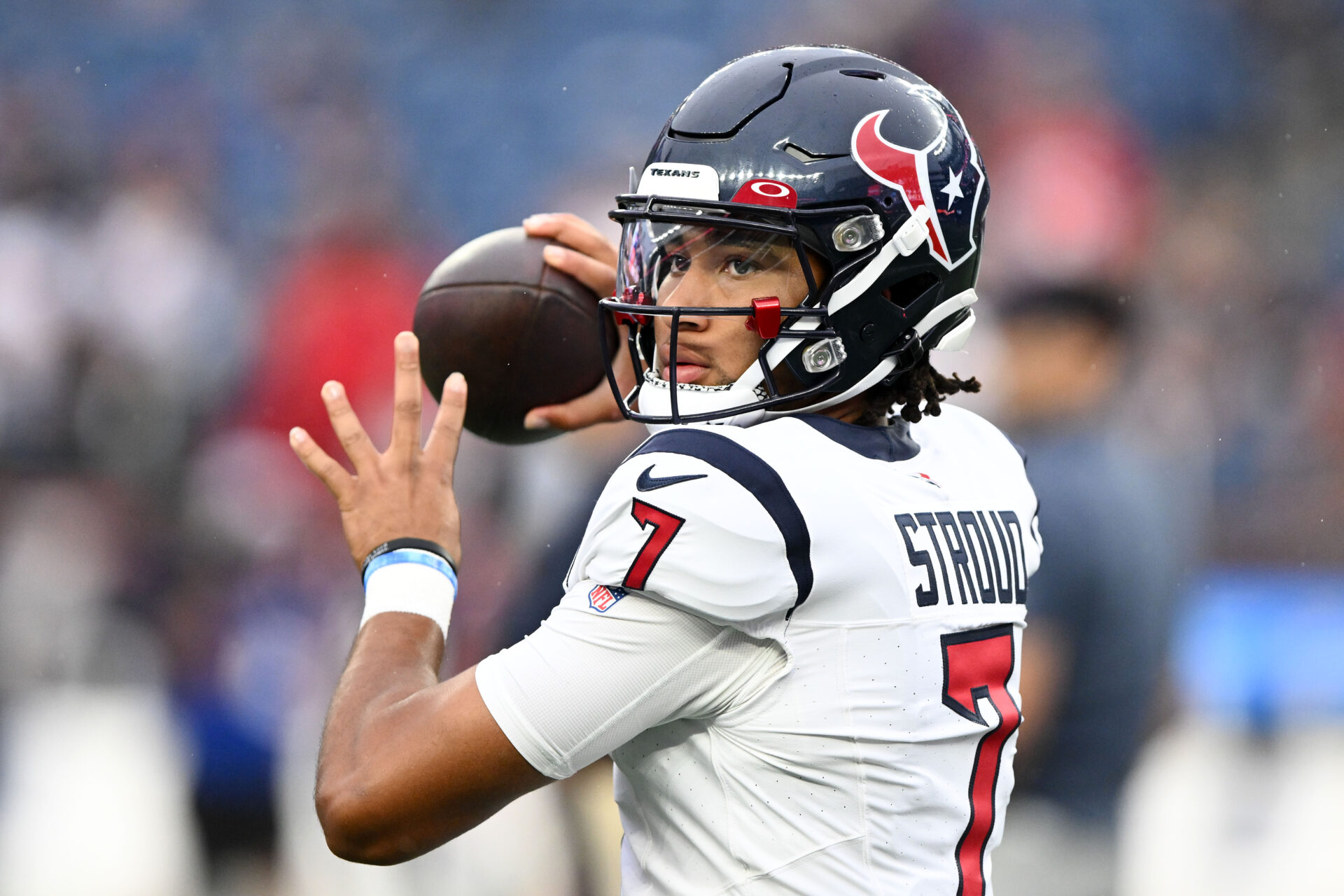Analysis
9/4/23
11 min read
First-Read: Key Questions Facing Each Rookie QB Entering Week 1

With 2023 first-round picks Bryce Young, C.J. Stroud and Anthony Richardson slated to start Week 1, it is time to take a look at their preseason tape to create a general baseline for a periodic, season-long analysis of their progress.
While the preseason is not necessarily indicative of regular-season performance, there are reasonable takeaways that can be collected from these quarterbacks’ first snaps in an NFL uniform.
>>WATCH: How Rookie QBs Will Fare
Each of these rookies enters the regular season with considerable hype, but there are questions about all of them that will determine whether they’ll meet initial expectations.

 Bryce Young, Carolina Panthers
Bryce Young, Carolina Panthers
Preseason Stats Overview:
Young appeared in all three games this preseason, completing 14 of 24 passes, good for a very average 58.3 percent completion rate, the highest among the three rookies. He threw for 129 yards (5.4 yards per attempt (YPA)) and one touchdown and did not turn the ball over.
The red flag regarding what’s ahead is he was pressured at an alarming rate (35.5 percent) and took the most sacks among the trio (four).
Q1: Will Young’s Play-Making Ability Translate Immediately?
Young’s elite sense of calm under pressure, quick decision-making, intangibles and consistent play-making ability are what made him special at Alabama. Although there were a number of good throws on his preseason tape that show the player he can become, there were also misses, off-target throws and times where he tried to make more out of the play than what was there. It is evident there is work to be done to adjust to his new receiving corps and to get used to the speed of the NFL game.
At Alabama, Young successfully completed awkward and off-platform throws consistently, which often translated into big plays. In his brief preseason action, while his ability to escape the pocket was evident, it did not lead to any explosive plays. This is not unusual and becomes even more obvious when you are a first-year player under pressure in the pocket without a viable protection or game plan.
There is no doubt that, at some point, the play-making ability that made Young the No. 1 overall pick will start to show up more often. But a number of significant elements to his game and to the Carolina Panthers’ offense will have to come together first.
Q2: Can Young Handle Internal Pocket Pressure?
As mentioned, Young took the most sacks of any of the three aforementioned rookies this preseason, and much of that pressure came up the middle.
It was apparent while watching the Panthers’ preseason game against the New York Giants what the league’s formula to defend Young will be:
1) Pressure the middle of the pocket with five rushers; 2) Create 1-on-1s with Carolina’s offensive line and push the line of scrimmage to force the undersized Young to throw over the top or into tight lanes of the coming rush.
This plan proved effective against Young in the preseason. Teams will also plan to push the pocket on his right side to force him out of the pocket to his left, away from his dominant right arm side.
Young’s ability to stay calm and make quick, correct decisions while under this chaotic interior pressure and to deliver accurately against man-to-man press coverage will be a determining factor in his early-season success.
In all NFL offenses, the No. 1 priority in the passing game is to protect the quarterback. Young has overcome his 5-foot-10 stature to this point, but it is critical that the Panthers’ offensive line keeps him clean and standing early, so he can find passing lanes and finish his throwing motion.
A significant amount of first-quarter hits on the quarterback can have residual negative effects on the play caller and player. With a decorated play caller in Frank Reich and a unique, elite athlete and talent in Young, it will be interesting to see how the Panthers handle the inevitable early adversity that can ultimately lead to their collective success.
Q3: Can Young Win from the Pocket at the NFL Level?
While Young’s innate play-making qualities will lead to some exciting plays, he needs to work on his game management and needs to play continuity football from the pocket. As the personality of this Panthers team asserts itself, Young’s self-awareness, functional intelligence and understanding of continuity football will be critical.
In the preseason, Young was decisive and showed an ability to quickly work through his progressions. I could argue there were a couple of incorrect reads, but that would be an unfair assessment because I am not in the quarterback room.
He made good decisions in the quick game, particularly when he had space to complete a throwing motion. There were also a handful of aggressive throws made from the pocket that flashed high-level accuracy, such as the touchdown pass against the Detroit Lions to the newly acquired Adam Thielen.
Bryce Young to Adam Thielen for the first touchdown of his career!
pic.twitter.com/qOROsDq2nk— JPAFootball (@jasrifootball) August 26, 2023
However, throughout the preseason, Young made a handful of poorly located throws, particularly against tight man coverage. Accuracy is at the top of the list of traits all quarterbacks must have. Young was accurate in college, and his continued growth and understanding of what defenses are doing to him are worth monitoring.

 C.J. Stroud, Houston Texans
C.J. Stroud, Houston Texans
Preseason Stats Overview:
In three games, Stroud threw the least number of passes (20) among the three rookies and had the lowest YPA (4.5). He completed 55 percent of his throws for 89 yards and had one touchdown and one interception. Despite Stroud facing a similar pressure rate to Young, the Houston Texans’ quarterback took just one sack.
Q1: Will Stroud Continue to Be More Decisive?
At Ohio State, while surrounded by a star-studded supporting cast, Stroud looked completely in control of the offense and was decisive.
In his first preseason game against the New England Patriots, he did not look like the same quarterback, double-pumping, holding the ball too long, taking longer to read coverages and generally looking unsure of himself on multiple occasions.
While Stroud made a handful of questionable decisions and forced a few passes, it was encouraging to see the growth in his decisiveness from the first preseason game to the third.
On his final preseason throws, he looked more confident, finishing his progressions when he had time and showing an understanding of pass protection. On two occasions, he completed passes to hot receivers with free rushers in his face.
Q2: Can Stroud and His New Offense Mesh Early?
The Texans, with a rookie quarterback and a first-time offensive coordinator, will need both to grow in tandem throughout the season. This means communication is a high priority. There will be nuances to their relationship and coordinating variables and inconsistencies that will show up on the tape. This is not unusual, but the momentum in Stroud’s play from the first preseason game to the third was noticeable and encouraging.
For new OC Bobby Slowik, getting Stroud comfortable with the details of this offense will be important. For Stroud, finding chemistry with his new cast of receivers will help Slowik’s play calls become more profitable. At Ohio State, Stroud had an innate understanding of where his receivers would be on any given play. Soon enough, he should have that same understanding of the Texans’ offense.
Q3: Can Houston Use Stroud’s Arm Talent and Ability to Extend Plays?
Despite some of Stroud’s struggles in preseason, his high-end arm talent and mechanics were still on display. By the end of the preseason, you could see elevated confidence in his drop-back footwork and understanding of the scheme, giving us a glimpse of the arm talent that made him the No. 2 pick in this year’s draft.
While he has only sufficient athleticism, he displayed an ability to make plays with his arm while outside of the pocket in either direction.
With an unsettled offensive line, we should see an emphasis on play-action passes under center and in the gun (out of the San Francisco 49ers’ recent playbook) and movements that get Stroud outside the pocket. He had plenty of success doing this in college, and this translated to the preseason tape, as well.
 Anthony Richardson, Indianapolis Colts
Anthony Richardson, Indianapolis Colts
Preseason Stats Overview:
There was a clear emphasis on getting Richardson much-needed reps in the preseason because the Indianapolis Colts named him their Week 1 starter despite his lack of collegiate starting experience.
Playing in two preseason games, Richardson attempted the most passes (29) among the rookie quarterbacks, completing 13 of them at an unacceptable 44.8 percent rate. Richardson threw for 145 yards on 5.0 YPA with one interception and did not find the end zone.
There were encouraging moments when he showed the ability to get the ball up and out quickly and move in the pocket, which helped his offensive line keep his pressure rate the lowest out of the three rookie quarterbacks (23.5 percent).
Q1: Can Richardson Limit the Ill-Advised Throws?
Richardson has dynamic arm talent and appears to believe he can make it all happen on any given play. While that is a good mindset to have, he needs to understand when to make the safe play to limit turnovers. When under pressure, his self-confidence leads him to make some ill-advised and reckless throws. This was an issue for him at Florida and was on display again in the preseason.
During the preseason, Richardson made quick, accurate throws off counter pass action, which minimized the difficult progressions and decisions that get him into trouble. First-year coach Shane Steichen — an experienced play caller — will likely modify the installation process in this way to allow Richardson to develop.
While Anthony Richardson’s throw to Alec Pierce was beautiful, to me this pass to Kylen Granson was AR’s best throw of the day. pic.twitter.com/xSh1iRIbjJ
— CLouisBag💼 🏈🏀⚾️🥊 (@droppedballspod) August 13, 2023
Richardson displayed jaw-dropping arm talent on a number of throws, but the biggest question mark in his game is his understanding of the No. 1 job of a quarterback: ball protection. In his 29 preseason passes, indecision, ill-advised throws and accuracy issues showed up.
Q2: How Quickly Can Richardson Improve His Mechanics?
Throughout the preseason tape, Richardson’s throwing mechanics appeared to be all over the place, which led to inaccuracy.
On many occasions, his footwork, throwing mechanics and arm angles led to errant throws. His awkward arm angles simply appeared unnecessary at times. Richardson’s inability to consciously change speeds and soften up his throws to create a more catchable ball will be assessed early on.
His staging of the ball appears to have already improved since his time at Florida, but he needs to focus on having a more consistent throwing motion to improve his ball placement. His 44.8 percent completion percentage from the preseason must dramatically improve.
Based solely on the preseason, it is arguable that, from a mechanical perspective, Richardson is not ready to be an NFL starting quarterback. But the exciting part of this decision is that Colts fans — and the football world in general — will be on the edge of their seats every snap to see how this incredible athlete will develop each week.
Q3: How Will Indianapolis Use Richardson’s Elite Athleticism?
Richardson is a truly elite athlete. Right now, he is simply an athlete first who will be a work in progress throughout the season.
One would expect Steichen will have to use Richardson’s rushing ability to force opposing defenses to defend all 11 players on offense. Any defensive coordinator will tell you that defending all 11 on every down takes much more work and preparation.
Indianapolis never put Richardson’s rushing ability on display in the preseason, but we should expect to see the Colts unveil a significant quarterback run package in Week 1.
It will be interesting to see how Steichen balances the need to use his quarterback’s explosive athleticism to move the ball while keeping Richardson healthy. His 6-foot-4, 245-pound frame will certainly help him withstand the physicality of NFL defenders.
So let’s get the season started. There is much to look forward to and discuss in the weeks ahead.
Marc Trestman is a former NFL, CFL and college coach. After more than a decade as an offensive coordinator and a quarterback coach in the NFL, he coached in four Grey Cups in the CFL, winning three over seven years with Montreal and Toronto before becoming head coach of the Chicago Bears. Follow him on Twitter at @CoachTrestman.









